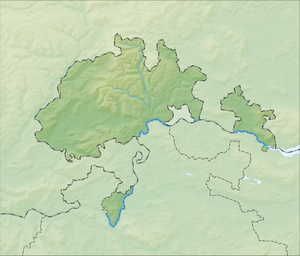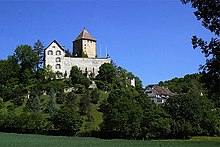Herblingen Castle
| Herblingen Castle | ||
|---|---|---|
|
Herblingen Castle with Stetten in the background |
||
| Creation time : | 13th Century | |
| Castle type : | Spurburg | |
| Conservation status: | inhabited castle | |
| Standing position : | Barons | |
| Geographical location | 47 ° 44 '0.6 " N , 8 ° 39' 40.3" E | |
| Height: | 520 m above sea level M. | |
|
|
||
The Herblingen Castle is a 13th-century castle . It stands on the district of Stetten in the canton of Schaffhausen , Switzerland . The castle and the castle park are privately owned and no longer open to the public.
history
Not much is known about the history of Herblingen Castle. Exactly when the castle was built is not known. It was probably built by the Lords of Herblingen at the beginning of the 13th century . It has not been proven whether a previous system already existed in the same location. The Herblinger family, which died out in the middle of the 15th century, was first mentioned in 1181 with a Rüediger. Whether this really belonged to the family is open. According to an old, unsettled tradition, Pope Leo IX should be around 1049 . have consecrated the castle chapel . In 1281 a Konrad von Herblingen rebuilt the castle chapel. Bishop Albert consecrated the chapel on behalf of the Bishop of Constance . Herblingen Castle was sold to the Dukes of Austria at the beginning of the 14th century . These appointed their administrators who pledged the castle to the Truchsessen von Diessenhofen in 1323 and 1344 . The Schaffhausen patrician Adam Cron bought Herblingen Castle in 1469. The Cron family passed it on to Master Hans Löw von Schaffhausen in 1502. Another change of ownership took place in 1507. Beringer von Landenberg acquired the castle. The city of Schaffhausen bought the castle from his widow Dorothea von Landenberg in 1534. In the same year the city lent the castle to the Brümsi family . Although the Reformation had taken place in Schaffhausen , the Catholic mass was still celebrated in the castle chapel. The castle came under the control of the city again in 1565. Between 1566 and 1733 the castle was the seat of the Upper Bailiwick of Reiat .
The bank director Johann Wilhelm Gestefeld from Vienna bought the castle in 1733 and converted it into a palace. By removing the battlements , the drawbridge and the ring walls , he completely changed the appearance of the medieval castle. The trenches were also filled in. In 1779 Wilhelm Gestefeld went bankrupt. From then until 1833 the castle belonged to the von Meyenburg family. This was followed by over 20 different owners. In the 20th century the castle tavern housed a restaurant and antique shop that was well known in the region for several decades. After another change of ownership, the restaurant and antique shop were closed. In 1998 the Christies auction house auctioned a collection of art objects that the late owner had assembled in the castle. In 2000 the brothers Peter and Stephan Günthart, owners of the Günthart company, acquired Herblingen Castle as a company and private residence.
Although the castle is in the area of the municipality of Stetten , it gave the small municipality of Herblingen its name. Herblingen was incorporated into the city of Schaffhausen in 1964 .
investment
The oldest part of the complex is probably the 13th century keep . The castle was able to retain its medieval appearance until 1733. The major renovations by Wilhelm Gestefeld from 1733 destroyed the original character of the castle. As a result of the renovations, especially the manor house , the complex now has more of a castle-like character.
literature
- Ernst Wanner: Herblingen Castle and its owners in the 18th and 19th centuries , in: Schaffhauser Contributions to History 57 (1980), pp. 7–33.
Web links
- Ulf Wendler: Herblingen (castle). In: Historical Lexicon of Switzerland .
- Burgenwelt: Herblingen Castle
- Website of the municipality of Stetten on the history of Herblingen Castle
- Herblingen Castle on burgseite.ch



